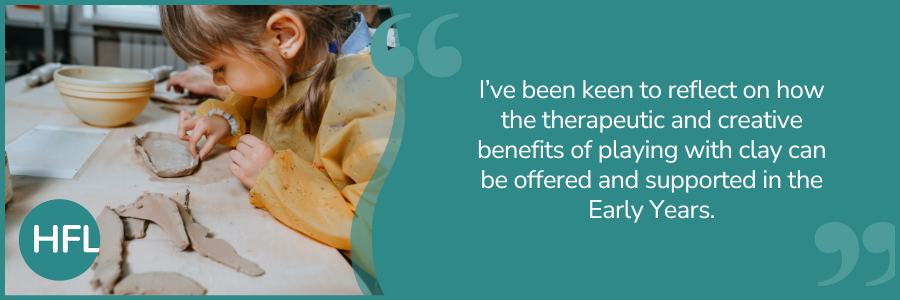
Memories and motivation
I think I only had clay classes for about a term in secondary school, but they were my favourite. The promise of what a lump of the grey stuff that smelt of the earth could become, the satisfaction of rolling out perfect coils and the patience required to wait for the finished, glazed pot from the kiln are core memories.

Recently, to carve out more time for myself (excuse the clay pun!) I’ve re-started classes at a friendly studio located near to me in North London. As I’ve been working through the classes, I’ve been keen to reflect on how the therapeutic and creative benefits of playing with clay can be offered and supported in the Early Years.
Clay as a malleable material
Clay is a natural material and has unique properties in terms of its ability to be moulded, left to harden, made softer, carved into, rolled flat or joined. The history and use of clay is interesting to explore with children as the earliest clay tablets and writing date back to 3300BC and ancient clay pots, pipes and decorative jugs tell us so much about civilisations long ago.

The beauty of clay is that it is open ended, an ‘intelligent’ material, and can be anything at all that a child wants it to be. The possibilities clay holds for children far surpasses our own ideas and expectations and gives a child the opportunity to represent in both two-dimensional and three-dimensional form.
Ordinarily available provision
Clay can be handled and explored by children of all ages who can then follow their own interests as they explore it in a way that is developmentally appropriate to them. This might start with exploring a huge lump of clay in a tuff spot, pulling off bits, adding water, pressing natural materials into it or simply exploring its consistency by covering their hands and arms with it. Later, children might start to use it to represent objects or forms that they are more familiar with, possibly even learning how to dry or fire their creations to produce a more permanent object.
If clay is available regularly, as ordinarily available provision, children will quickly develop their ideas with increasing complexity, detail and focus.
Tips for setting up a clay area
- Tools are not necessary at first, they can be introduced as and when you want to move learning on or introduce a technique such as trimming or smoothing. Remember at first, that children will benefit from long periods exploring the material with their whole bodies without a pre-determined product.
- Introduce clay as a large solid lump to start with and make water available so that it doesn’t dry out. In my experience, discarded, used clay can be squidged together again and if kept in a sealed plastic bag or wrapped in a damp cloth it can be used again and again.
- Encourage children to use every part of their hands to explore the clay; their hands are the most important tool. Model to them how to use their knuckles, fingertips, fists and palms. They will quickly discover that how the clay behaves is led by their hands.
- Ensure staff are aware of the skills that they might like to model such as sculpting, rolling, engraving, pressing and patting. Consider what this progression might look like over time for children in your EYFS.
- Mister bottles used for plants are good for keeping the clay lightly damp whilst children explore it.
- Large wooden boards are good for working on but tuff spots or covering tables with hessian or cotton sheets work well too.
- If adding water, then consider tools which will not ‘flood’ the clay such as pipettes, small spray bottles or paint brushes.
- Clothing such as baggy T shirts or overalls work best for clay play. Clay washes out easily.
Development of knowledge and skills
As children explore clay and become confident with it, you might want to consider looking at how clay is used by other artists and ceramicists with children, or even visit a local studio to see pots being thrown on a wheel.
You might also want to look at more technical skills such as slab work, using slip to join, or even making simple pinch pots and building up height with coils. Some schools I know have worked with community artists on a group or class project, the opportunities are endless.
As ever, I have only touched on the possibilities open to you by introducing clay into your classroom. For a much more comprehensive look, please look at the Froebel ‘Exploring Clay’ pamphlet below, and if you do decide to develop the use of clay in your setting, we’d love to hear from you.

Resources
Exploring Clay pamphlet - written by Lucy Parker, Deputy Headteacher at Ludwick Nursery School in Hertfordshire



